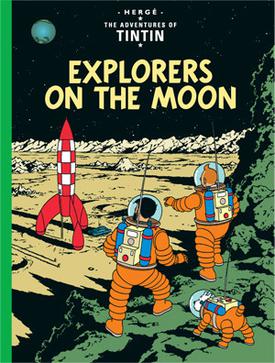That the United States successfully landed the first human beings on the moon in 1969 is common knowledge. However, it is less commonly known that many details of this momentous accomplishment were predicted by science fiction decades prior to the actual event.
Here are, in chronological order, five correct predictions science fiction made,(sometimes even inadvertently), about the first moon landing.
1. From the Earth To The Moon by Jules Verne (1887)-

You may be tired of hearing about Jules Verne by now. If so, too bad. This is a series on science fiction history. He is going to come up a lot. While the Apollo 11 mission didn’t see its crew members launched out of a giant cannon towards the moon, many of Verne’s calculations were close to feasible. Perhaps one of the most fascinating coincidences surrounding the story is that Verne’s characters blasted off from Florida. The first moon landing began at Kennedy Space Center, near Orlando, Florida.
2. Woman in the Moon directed by Fritz Lang (1929)-
Two years after his classic silent film Metropolis made cinematic history, director Fritz Lang released this tragic space romance, based off the novel written by his wife, Thea von Harbou. Though the man crux of the film is the drama, it did introduce viewers to new ideas about rocket travel, including the introduction of a multi-stage rocket.
3. Tintin- “Explorers on the Moon” by Hege (1954)-

Tintin was a serialized adventure comic by Herge, a Belgian cartoonist, starring a young reporter named Tintin. In 1954, Herge became interested in space travel, and decided to send his character along on the first manned mission to the moon. Inspired by Jules Verne’s From The Earth to The Moon, the 1950 film Destination Moon, and the real life German V-2 rocket, he crafted a technical and realistic tale of men on the moon.
4. The Outward Urge by John Wyndham and Lucas Parkes (1959)-

Though it appears to be co-authored by two people, the author-names listed for this novel are really just two pen names for the same person. John Wyndham created an intricate future history in which he painted a fairly accurate, if belated, picture of the early struggle to reach the stars, first moon landings, and first space stations.
5. Star Trek “Tomorrow is Yesterday” (1967)-

The plot of “Tomorrow is Yesterday” has become a staple trope of the Star Trek universe throughout its nearly fifty year history. The crew of the Enterprise must go back in time to study a specific period of history (in this case, the 1960s), and end up interfering more than they intended to. What makes this episode remarkable is a radio report announcing that the first manned mission to the moon was to take place that Wednesday. Two years later, on Wednesday, July 16th, 1969, Apollo 11 left earth’s atmosphere for the moon.
Keep on glowing in the dark,
Elora
No comments:
Post a Comment